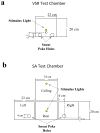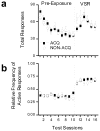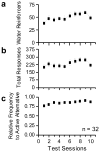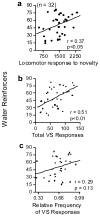Sensory reinforcement as a predictor of cocaine and water self-administration in rats
- PMID: 23142958
- PMCID: PMC3581756
- DOI: 10.1007/s00213-012-2907-6
Sensory reinforcement as a predictor of cocaine and water self-administration in rats
Abstract
Rationale: The ability of locomotor activity in a novel environment (Loco) and visual stimulus reinforcement (VSR) to predict acquisition of responding for cocaine and water reinforcers in the absence of explicit audiovisual signals was evaluated.
Methods: In Experiment 1 (Exp 1), rats (n = 60) were tested for VSR, followed by Loco, and finally acquisition of responding for cocaine (0.3 mg/kg/inf). In Experiment 2 (Exp 2), rats (n = 32) were tested for VSR, followed by Loco, and finally acquisition of responding for water (0.01 mL/reinforcer).
Results: There were three main findings. First, Loco and VSR were significantly associated (Exp 1: r = 0.49, p < 0.00; Exp 2: r = 0.35, p < 0.05). Second, neither Loco (r = .00, p = 0.998) nor VSR (r = -0.12, p = 0.352) predicted acquisition of cocaine SA. Third, in the subgroup of animals that acquired cocaine SA, VSR (r = 0.41, p < 0.01) but not Loco (r = 0.28, p = 0.10) was positively associated with operant responding for cocaine. Both Loco and VSR (Loco: r = 0.37, p < 0.04; VSR: r = 0.51, p < 0.00) were positively associated with operant responding for water reinforcers.
Conclusions: The results indicate that VSR is at least as good a predictor of cocaine reinforced responding as Loco. VSR was predictive of operant responding for both drug and water reinforcers, while Loco was found to be predictive of responding only for water reinforcers. In studies that present visual stimuli in association with drug delivery, Loco may be predicting acquisition of responding for VSR rather than drug.
Figures








References
-
- Andrucci GL, Archer RP, Pancoast DL, Gordon RA. The relationship of MMPI and Sensation Seeking Scales to adolescent drug use. J Pers Assess. 1989;53:253–66. - PubMed
-
- Bornovalova MA, Cashman-Rolls A, O’Donnell JM, Ettinger K, Richards JB, deWit H, Lejuez CW. Risk taking differences on a behavioral task as a function of potential reward/loss magnitude and individual differences in impulsivity and sensation seeking. Pharmacol Biochem Behav. 2009;93:258–62. - PubMed
-
- Caggiula AR, Donny EC, Chaudhri N, Perkins KA, Evans-Martin FF, Sved AF. Importance of nonpharmacological factors in nicotine self-administration. Physiol Behav. 2002a;77:683–7. - PubMed
Publication types
MeSH terms
Substances
Grants and funding
LinkOut - more resources
Full Text Sources

